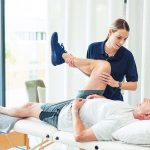By Paul D. Protomastro, M.D. Hand & Upper Extremity Surgeon, OrthoConnecticut

A direct blow to the bony prominence of the elbow may result in an acute tear or swelling of the tendon that can lead to degeneration. A sudden extreme action, force, or activity, such as starting a lawn mower, can also injure the tendon. The most common age group that this condition affects is between 30 to 50 years old. It affects both men and women with equal frequency. Pain is the primary reason for patients to seek medical evaluation. With tennis elbow the pain is located over the outside aspect of the elbow, over the bone region known as the lateral epicondyle, and is exacerbated by overhand lifting or power grip activities. With golfer’s elbow the pain is on the inside part of the elbow (medial epicondyle) and exacerbated by resisted wrist flexing or underhand lifting. The bone and tendon insertion often becomes tender to touch. Pain is also produced by any activity which places stress on the tendon, such as gripping or lifting. With activity, the pain usually starts at the elbow and may travel down the forearm to the hand. Occasionally, any motion of the elbow can be painful.
The bone and tendon insertion often becomes tender to touch. Pain is also produced by any activity which places stress on the tendon, such as gripping or lifting. With activity, the pain usually starts at the elbow and may travel down the forearm to the hand.
There are several theories as to why the elbow is so prone to these tendon injuries. Firstly, these tendons are taut and under great stress with repetitive wrist and hand activity. Secondly, the tendon origin is very small relative to the muscles that attach to them which leads to high forces on a tiny insertion site. Thirdly, these tendons have a very poor blood supply and take a long time to heal. All these factors result in prolonged pain and dysfunction in most cases. On average a case of tennis or golfer’s elbow takes 12-18 months to fully heal. On rare occasions people can be pain free and return to their sports, work or hobbies in 2-3 months.
TENNIS ELBOW TREATMENT OPTIONS
Activity modification
Initially, the activity causing the condition should be limited. Limiting the aggravating activity, not total rest, is recommended. Modifying grips or techniques, such as use of a different size racket and/or use of 2-handed backhands in tennis, may relieve the problem.
Medication
Anti-inflammatory medications may help alleviate the pain temporarily to make the tendon tear heal.
Bracing
A tennis elbow brace, a band worn over the muscle of the forearm, just below the elbow, can reduce the tension on the tendon and decrease pain while using the arm and possibly allowing the tendon to heal.
Occupational Therapy
May be helpful, providing stretching and/or strengthening exercises. Ultrasound, lasers, deep friction massage and heat treatments may be helpful by increasing blood flow and decreasing pain.
Steroid injections
A steroid is a strong anti-inflammatory medication that can be injected into the area. These injections have been shown to temporarily decrease the pain of elbow tendonitis but do not help the tear heal. In fact, steroids may further harm the tendon and lead to chronic tendon damage. No more than (3) injections should be given.
Surgery
Surgery is considered when the pain is incapacitating, has not responded to conservative care, and symptoms have lasted more than six months. Surgery involves removing the diseased, degenerated tendon tissue and then repairing healthy tendon back to the humerus bone. This 15-20 minute procedure is performed in the outpatient setting under sedation and local anesthesia. Recovery from surgery requires physical therapy to first regain motion of the arm and then a strengthening program after 6 weeks. Most patients can return to usual activities by 3-4 months. Complete recovery, including a return to tennis, golf and high impact/repetition work, can be expected to take 4–6 months. The success rate of this surgery is over 90%.



















